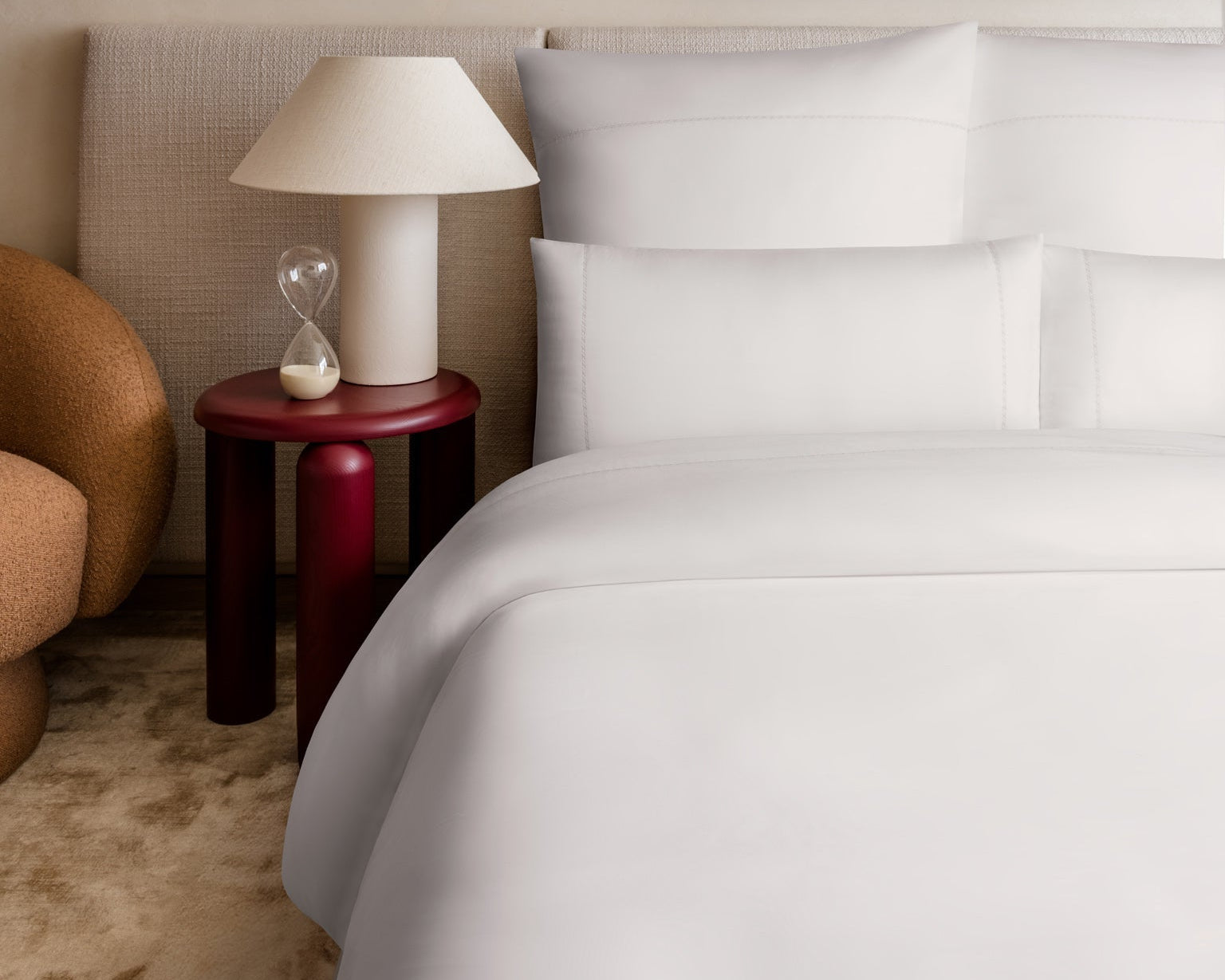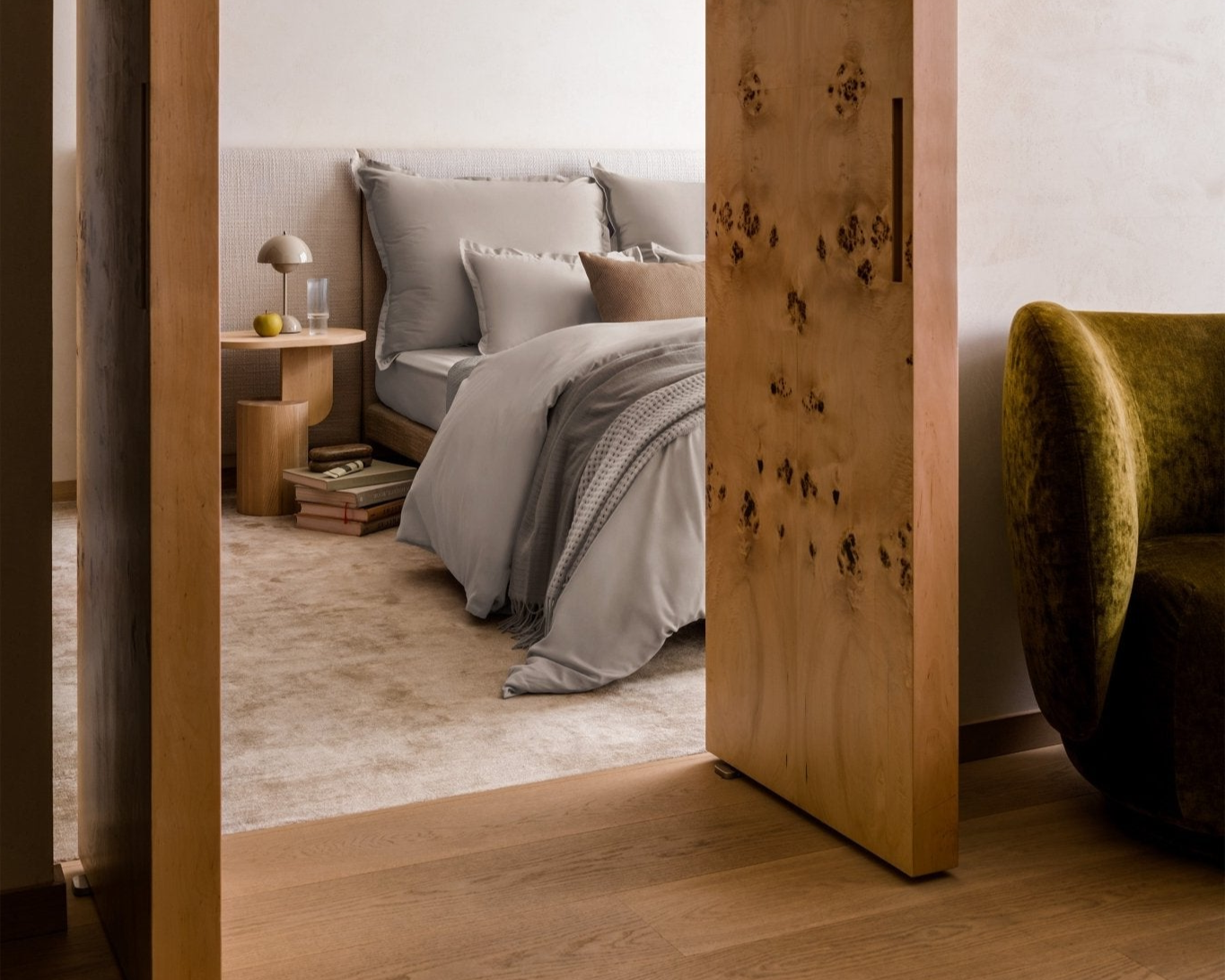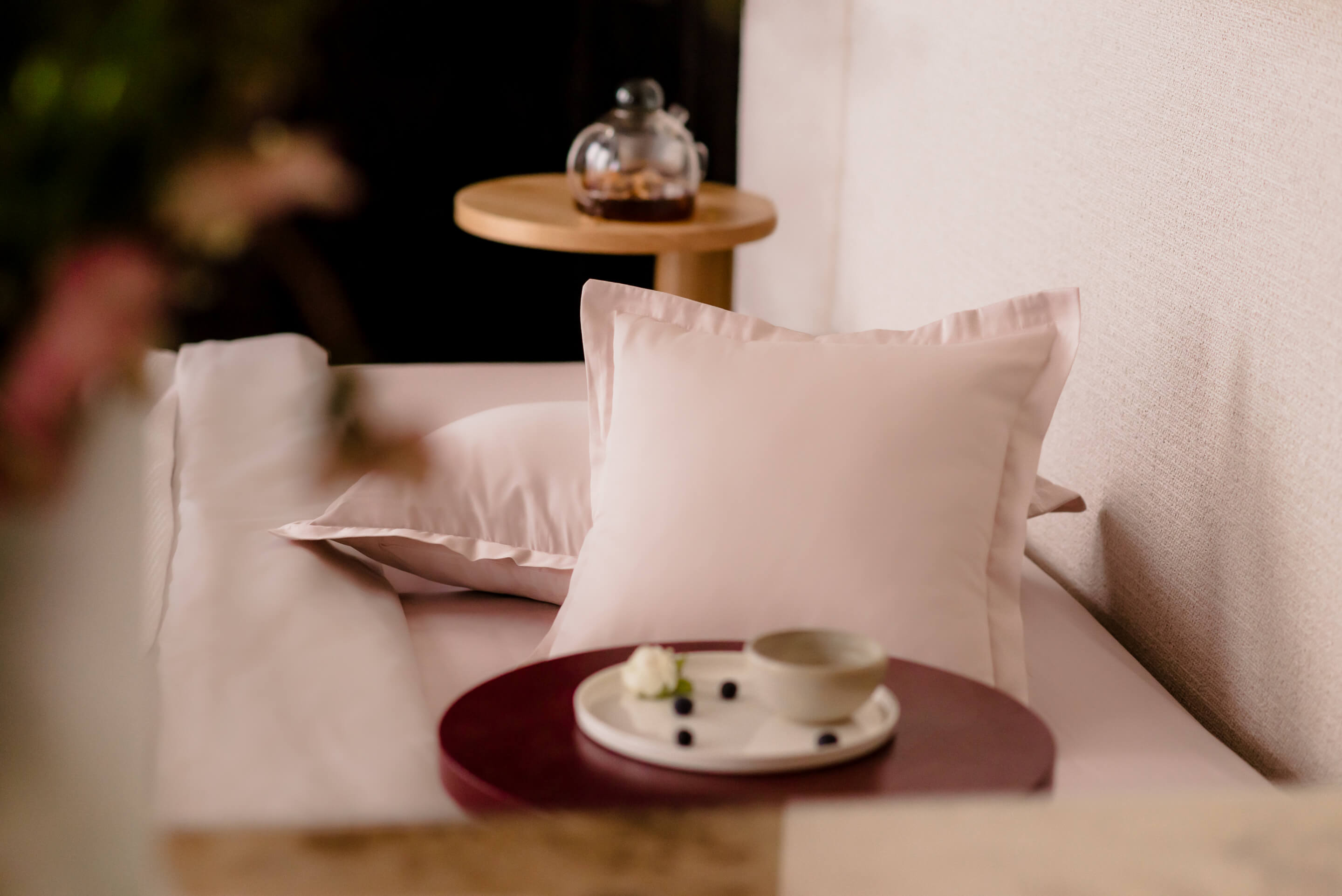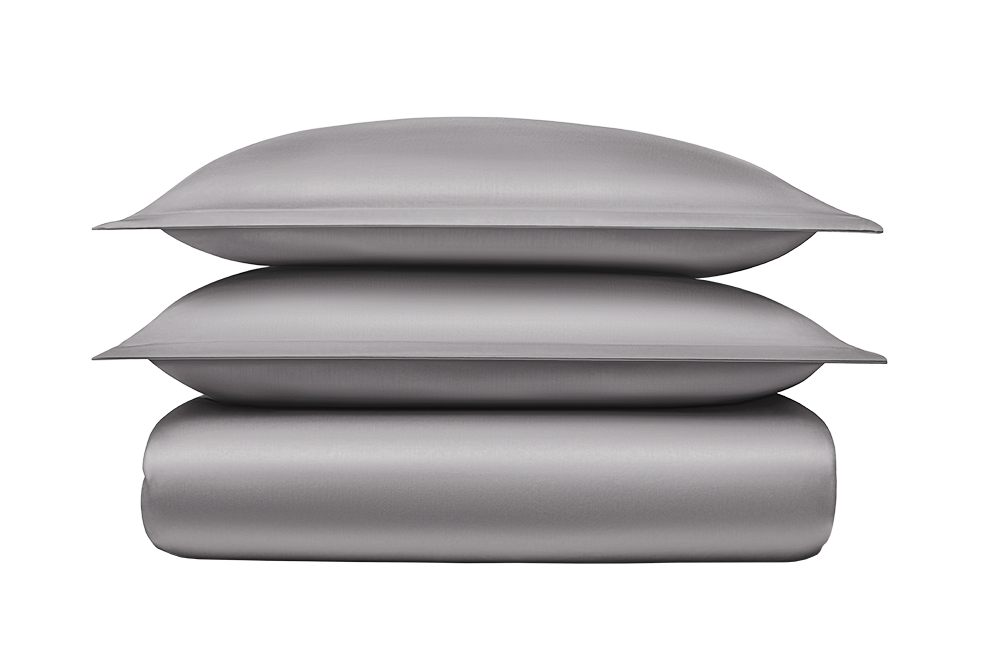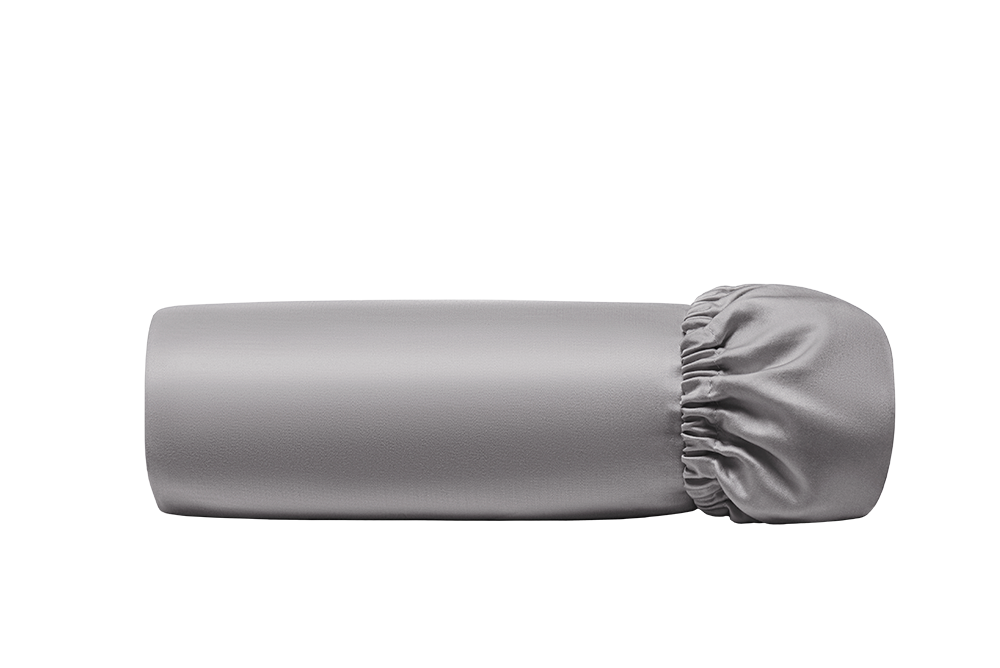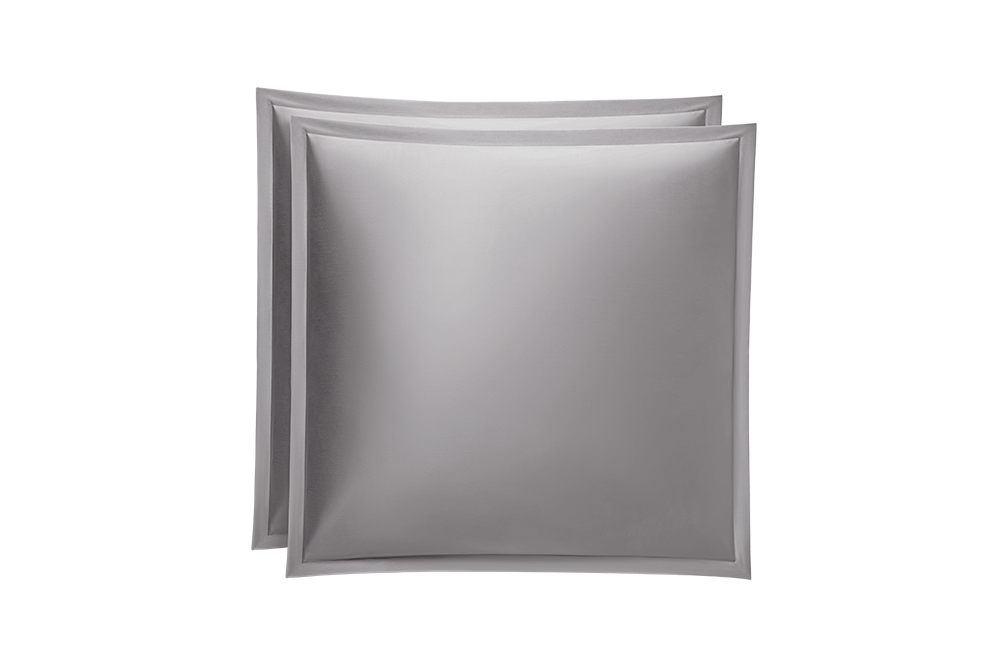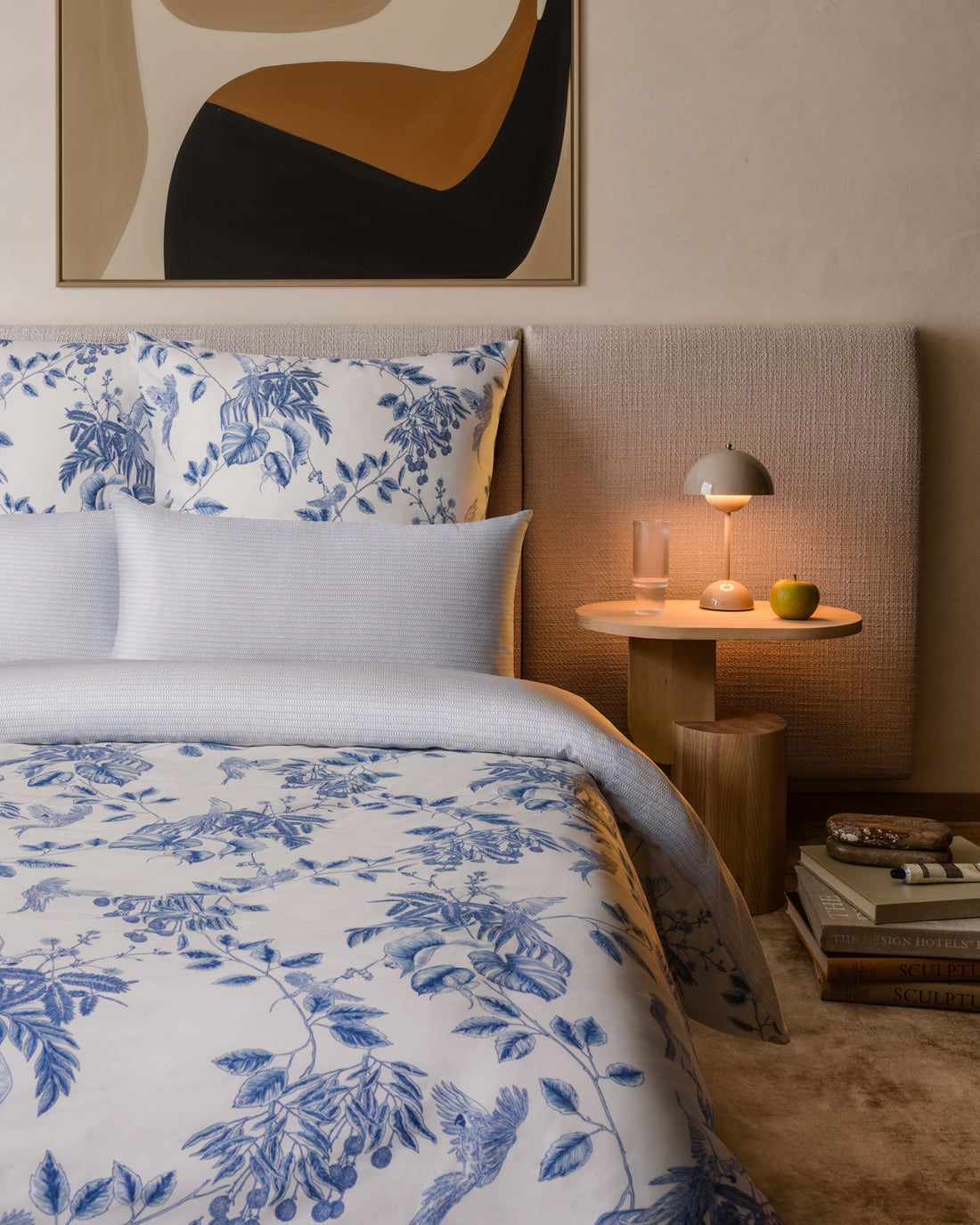What is satin or sateen?
Satin or sateen is often mistakenly thought of as a fabric. In fact, it is a weaving technique that involves intertwining threads to create a material. The satin weave creates a smooth, shiny surface on one side while the reverse side remains matte - a feature that gives the fabric a luxurious appearance. Satin can be made from a variety of fibers, such as cotton, silk or polyester. However, we only use cotton.
What is the difference between satin and Mako satin?
Satin is a weaving technique that can be applied to different fibers to create fabric. The most affordable satin bedding is usually made from polyester and microfiber - both man-made materials derived from petroleum. In the world of bedding, however, the term "Mako satin" traditionally refers to fabric made from high-quality Egyptian cotton. Today, the term is also occasionally used to market lower-quality cotton. Strictly speaking, Mako satin bedding should only be made from first-class Egyptian cotton, particularly the Giza variety grown in the Nile Delta. This high-quality cotton is famous for its exceptional softness, durability and luxurious feel.
What is the difference between satin and percale bed linen?
Satin bed linen impresses with its shiny, shimmering surface, which is created by the special weave, and gives it an elegant, luxurious appearance - a look that is particularly popular in Germany. In contrast, percale bed linen is made in a simple, straight weave, which results in a cool, matt surface. Both types of bed linen are suitable all year round; however, percale is particularly beneficial for people who tend to sweat a lot at night. Ultimately, personal preference decides: satin impresses with its elegant shine, while percale impresses with its cool, simple mattness.
Where does the name “Mako” come from and how is it related to Egyptian cotton?
The name "Mako" is derived from Maho Bey El Orfali, a retired high-ranking Turkish-Egyptian official. In 1819, French textile engineer Louis Alexis Jumel discovered a special variety of cotton in Maho Bey's private garden in Cairo. Jumel recognized the potential of this cotton and reported it to the then ruler of Egypt, Muhammad Ali Pasha, laying the foundation for the world-famous Egyptian cotton sector. The cotton that later became famous as Giza cotton due to its long, fine fibers and outstanding quality is inextricably linked to Maho Bey's garden. Thus, the term "Mako" honors Maho Bey El Orfali and is emblematic of the superior quality and historical importance of Egyptian cotton that emerged from this first discovery.
How does Mako satin feel?
Mako satin is known for its luxurious, silky-smooth texture and radiant shine. It is made from Mako cotton, an extra long Egyptian cotton variety (ELS), and woven in a satin weave that enhances its softness and shimmer.
Main features of Mako satin fabric:
Soft & Silky: Exceptionally smooth, often compared to silk.
Light & Breathable: Airy and comfortable on the skin.
Shiny & Elegant: A beautiful shimmer that underlines the premium image.
Typical applications for Mako satin:
Luxurious bed linen and pillowcases that gently hug the skin.
High quality clothing (shirts, blouses, etc.) that offer both comfort and elegance.
Because Mako satin combines high-quality cotton with a satin weave, it creates an ultra-soft, smooth and slightly shiny surface - perfect for anyone who appreciates a touch of luxury.
Do you sweat in satin bed linen?
The breathability and moisture wicking properties of satin bedding depend largely on the fibers used. Traditional satin, woven from natural fibers such as high-quality Egyptian cotton (often referred to as Mako satin), tends to be more breathable and moisture-absorbent. This helps regulate temperature and wick away excess moisture, making you feel less hot or sweaty. In contrast, satin made from synthetic fibers such as polyester tends to trap heat and moisture. Those who tend to sweat too much while sleeping should therefore opt for bedding made from natural fibers.
What is the ideal thread count for satin bed sheets?
A thread count of 300 is often considered ideal as it offers a balanced compromise between a smooth, shiny surface and robust durability - without making the fabric too heavy. However, the quality of the cotton used is crucial, as high-quality fibers, such as premium Giza cotton from Egypt, deliver a luxurious feel and optimal breathability at 300 threads. In contrast, using lower-quality cotton at a higher thread count can result in a heavy, rough fabric that lacks the typical softness and elegance of satin. Ultimately, it is crucial to prioritize fiber quality over a purely high thread count to enjoy the best possible satin bedding experience.
Does satin bed linen wrinkle?
Satin bedding tends to wrinkle less than many other fabrics due to its smooth, shiny weave. However, the degree of wrinkle resistance depends on the fiber composition. Satin made from high-quality Egyptian cotton usually retains its shine and remains relatively wrinkle-free - although cotton can naturally wrinkle to a certain extent. Some manufacturers rely on chemical treatments, such as the use of formaldehyde, to create non-iron fabrics, for example. However, such treatments are a health risk. While synthetic satin is often even more resistant to wrinkles, it may not offer the same luxurious feel and retains heat, which can lead to increased night sweats. For optimal comfort and a first-class finish, it is therefore recommended to use satin bedding made from high-quality, natural fibers - and accept smaller, natural wrinkles rather than endangering your health with chemical additives.
How do you define and assess the quality of Mako satin bed linen?
Mako satin bed linen is valued for its silky texture, durability and breathability – however, not all Mako satin bed linen is of high quality. Some manufacturers skimp on quality by using inferior cotton blends or applying temporary coatings to simulate the feel of a premium fabric.
To ensure true, lasting luxury, consider the following key factors:
- Fabric composition – 100% Mako cotton versus blends
- High quality: Made from 100% Mako cotton (extra long Egyptian cotton), which ensures superior softness and durability.
- Inferior quality: Blends with polyester or inferior cotton are less breathable and wear out faster.
- Tip: Look for a certificate from the Cotton Egypt Association (CEA) instead of just saying “Egyptian cotton” to confirm authenticity.
2. Beware of artificial coatings that disappear after washing
- Some manufacturers apply chemical coatings that initially make the fabric appear artificially silky and smooth.
- After 2-3 washes, the coating washes out, transforming the previously soft fabric into a rough, matte and stiff fabric.
- High-quality Mako satin does not require such coatings – with proper care it becomes softer and smoother over time.
- Tip: If the fabric seems too silky or slippery straight out of the package, it may be coated. Pay attention to how the fabric changes after a few washes.
3. Thread count (TC) for Mako satin
- 300 TC: Offers the optimal balance of silkiness, durability and breathability.
- Less than 300 TC: May feel rough and wear faster.
- More than 800 TC: Can be misleading as multi-strand threads are often used, which limits breathability.
- Tip: A single-strand Mako satin with 300 TC retains its softness and shine in the long term.
4. Weave – Real satin weave for long-lasting smoothness
- Satin weave: Creates a shiny top and a matte bottom, providing the characteristic silky feel.
- Plain or percale weave: Does not offer the same smoothness and typical shine as real Mako satin.
- Tip: Run your hand over the fabric – real Mako satin should feel soft, smooth and silky.
Conclusion: What distinguishes premium Mako satin bed linen?
100% Mako cotton (no blends): Look for a certificate from the Cotton Egypt Association.
No artificial coatings:The fabric becomes softer over time and remains pleasant to the touch even after repeated washing.
300 thread count:Provides the perfect balance between silkiness and durability.
Real satin weave:Guarantees a shiny, breathable and silky smooth surface.
OEKO-TEX certified:Free from harmful chemicals and therefore harmless to health.
With these criteria, you can ensure that you invest in high-quality Mako satin bed linen that offers real luxury and long-lasting comfort.
What are the advantages of Mako satin bed linen?
- Silky smooth & soft: Feels incredibly luxurious on the skin and ensures a pampering experience every night.
- Breathable & Moisture-wicking: Regulates temperature naturally, prevents overheating and reduces sweating.
- Hypoallergenic & Gentle: Ideal for sensitive skin and hair as it minimizes irritation and allergic reactions.
- Durable & Hard-Wearing: Made from extra-long cotton fibers, it withstands daily wear and tear and retains its quality over a long time.
- Wrinkle-resistant & easy-care: Thanks to the smooth weave, it stays smooth for a long time, so little ironing is required.
- Elegant & Stylish: Adds a special touch to your bedroom with its noble, luxurious shine.
What are the disadvantages of Mako satin bed linen?
- Crease potential: Although Mako satin wrinkles less than regular cotton, it is not completely wrinkle-free. Polyester satin offers greater crease resistance, but has limited breathability and is made from petroleum, which contributes to microplastic pollution.
- Higher costs: Being made from high-quality cotton makes Mako satin more expensive than standard cotton or polyester satin. Cheaper alternatives may initially appear similarly soft, but do not last as long and can have negative effects on health and the environment.
